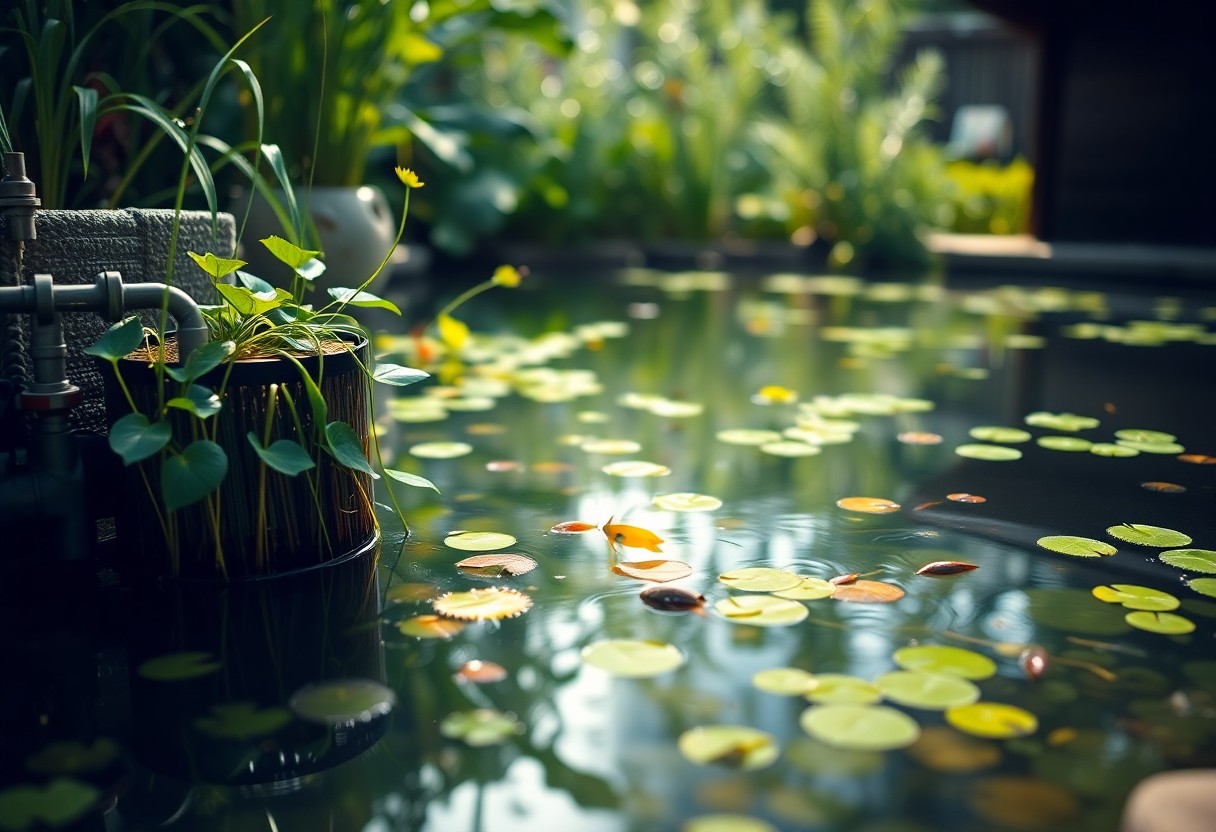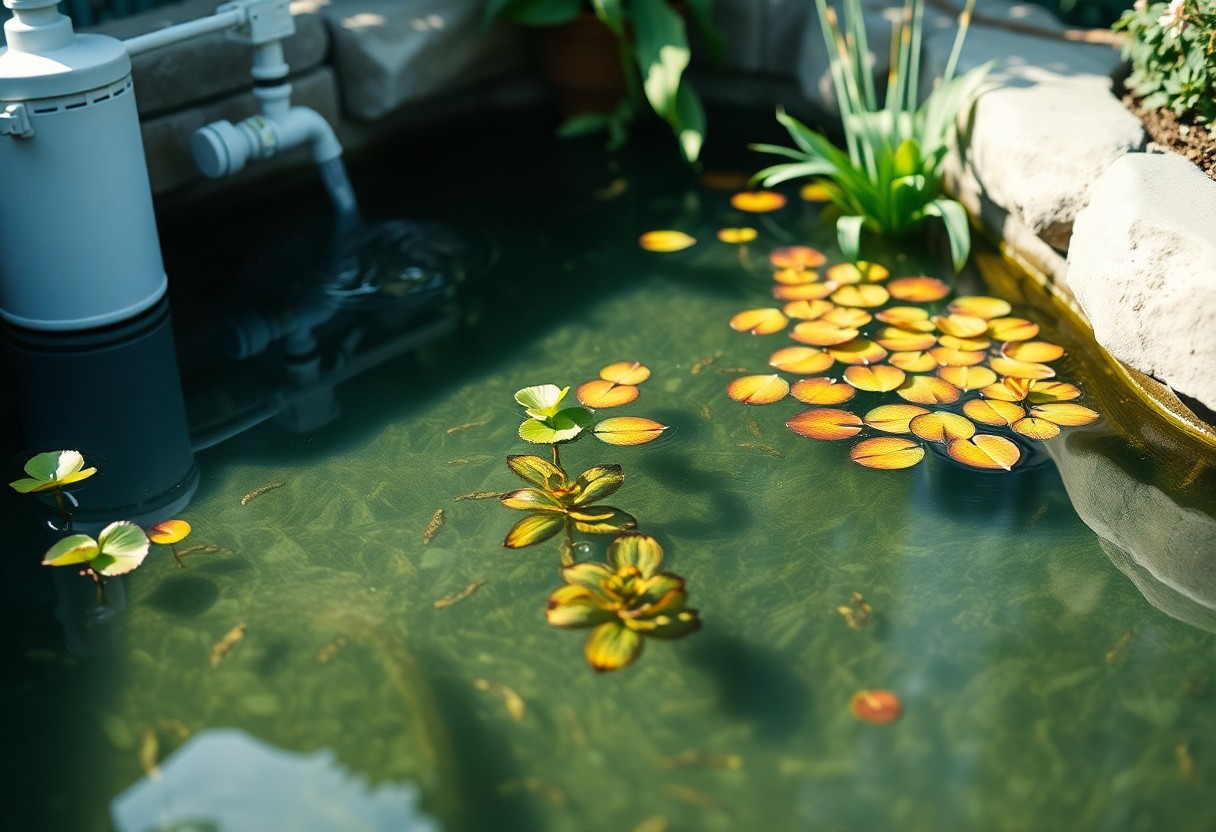This guide will help you understand how to effectively filter your garden pond water to maintain a clean and healthy aquatic environment. When you enhance the water quality, you not only promote the wellbeing of your fish and plants but also prevent the growth of algae and harmful bacteria. You’ll discover various filtration methods that suit your pond size and budget, ensuring you create a safe habitat. By following these steps, you’ll enhance the beauty of your garden and enjoy the soothing presence of a flourishing pond.

Table of Contents
Key Takeaways:
- Establish a balanced ecosystem by incorporating beneficial plants and fish that help clear the water naturally.
- Utilize mechanical filtration methods, such as a pond skimmer or filter pump, to remove debris and particles.
- Consider adding a biological filter to promote the growth of beneficial bacteria that break down harmful substances.
- Regularly check and maintain pH levels, as well as nutrient concentrations, to enhance water clarity and quality.
- Install a UV clarifier to effectively reduce algae growth, keeping your pond water clear and free of green discoloration.
Understanding Pond Filtration Basics
For anyone looking to maintain a healthy garden pond, understanding the basics of pond filtration is vital. A well-filtered pond ensures clean water, supports aquatic life, and prevents algae growth. Filtration systems work by removing debris, toxins, and harmful microorganisms, allowing you to enjoy a clear and vibrant aquatic environment in your yard.
Types of Pond Filtration Systems
For your garden pond, you may consider the following types of filtration systems:
- Mechanical Filters
- b>Biological Filters
- Chemical Filters
- UV Filters
- Pond Skimmers
Thou can choose the right system based on your pond’s size, fish population, and desired water clarity.
Importance of Proper Water Filtration
Water quality plays a vital role in the overall health of your pond and its inhabitants. Effective filtration removes debris, toxins, and excess nutrients, preventing harmful conditions that can threaten fish and plant life.
For instance, when you maintain optimal water conditions, you significantly reduce the risk of ammonia spikes and algae blooms that can lead to fish kills or water quality issues. Proper filtration supports a balanced ecosystem, ensuring that your pond remains a thriving habitat for both aquatic life and plants while minimizing unpleasant odors and clear visibility. Ultimately, investing time and resources into effective pond filtration will reward you with a vibrant and enjoyable pond experience.
Essential Filtration Components
There’s a variety of important filtration components you need to consider for maintaining clean and healthy garden pond water. Each component plays a vital role in the overall filtration system to effectively remove debris, manage waste, and promote a balanced aquatic ecosystem. Selecting the right combination of filters will ensure that your pond remains clear, provides a healthy environment for fish and plants, and minimizes the need for chemical treatments.
Mechanical Filters
Now, mechanical filters are the first line of defense in pond filtration. They work by physically removing larger particles, such as leaves and debris, from the water. Incorporating a reliable mechanical filter can significantly reduce the workload on your biological filtration methods, keeping your pond water cleaner for longer. Regular maintenance of these filters is important to ensure optimal performance and effectiveness.
Biological Filtration Methods
Components of biological filtration methods utilize beneficial bacteria to break down harmful substances in your pond water. This process is critical for establishing a healthy ecosystem, as it converts toxic ammonia and nitrites into less harmful nitrates. Fostering an environment with efficient biological filtration will not only enhance water quality but also promote the growth of plants, creating a balanced habitat.
Another key aspect of biological filtration methods is the establishment of a biofilter. This filter houses a colony of beneficial bacteria that thrive on organic waste. As they consume toxins in your pond water, they help maintain optimal water quality. It’s important to allow time for bacterial colonies to grow, as beneficial bacteria take weeks to establish and effectively process waste. Ensure you monitor water parameters to prevent any potential spikes in ammonia and provide a safe habitat for fish and plants.
Choosing the Right Filter
Your choice of filter can significantly impact the health of your garden pond. Consider factors such as pond size, water volume, and the type of fish you keep. A well-suited filter will ensure clean, oxygen-rich water. For those looking to save some money, you can explore options for a DIY Pond filter that matches your specific needs.
Pond Size and Volume Factors
Any filter you choose should be proportional to your pond’s size and volume. Here are some factors to keep in mind:
- Pond size: The larger the pond, the stronger the filter needed.
- Water volume: A higher water volume requires an efficient filtration system.
- Type of plants: Some aquatic plants can assist in natural filtering.
Assume that the right filter can help maintain water clarity and health.
Fish Population Considerations
One of the key factors in selecting a filter is the number of fish in your pond. A higher fish population increases waste production, necessitating a more potent filtration system to maintain water quality.
Factors that influence your filtration choice include the size of the fish, their activity levels, and their feeding habits. Larger and more active fish produce more waste, meaning you must ensure that your filter can handle the increased load. Additionally, a balance between aquatic plants and fish is important, as plants can help absorb excess nutrients and keep the water clear. Providing adequate filtration not only fosters a healthy environment for your fish but also minimizes the risks of toxic buildup in the pond.
Installation Process
All the components of your filter system must be installed properly to ensure optimal performance. Begin by determining the best location for your filter, keeping in mind your pond’s specific needs and features. Take your time during this step to guarantee a solid foundation for clean, clear water.
Filter Placement Guidelines
Little attention to detail with your filter placement can lead to inefficiency. Ideally, position the filter close to the water source, away from debris, and ensure it is accessible for maintenance. An appropriate height will also allow gravity to assist with water flow, maximizing filtration performance.
Setting Up the System
You will need to connect your filter to the pond’s pump system to start the filtration process. Ensure all connections are secure, and follow the manufacturer’s instructions for any specific setup requirements.
Filter orientation is important for achieving the best results. Position the inlet and outlet hoses securely, ensuring there are no leaks. Utilize clamps or clips to enhance stability. It’s critical to check the pH levels of the water before and after installation, which could indicate if your system is functioning correctly. Once everything is in place, turn on the system and monitor for any irregular sounds or flow issues that might point to a problem requiring attention.
Maintenance Requirements
Keep your garden pond clean and healthy by adhering to a proper maintenance routine. Regular maintenance is necessary for ensuring the longevity of your filtration system and the overall quality of your pond water. By dedicating time to maintain your pond, you prevent build-up of debris and toxins that can endanger your aquatic life.
Regular Cleaning Schedule
Maintenance of your pond requires a consistent cleaning schedule to remove debris, algae, and accumulated waste. You should inspect the pond weekly, ensuring the filters are clear and any organic matter is removed promptly. This helps keep water circulating effectively and maintains a healthy environment for your fish and plants.
Filter Media Replacement
Maintenance also includes the timely replacement of your filter media to ensure optimal performance. Depending on the type of filter and pond size, you may need to replace filter pads or cartridges every 6 to 12 months. Regularly replacing your filter media will help maintain good water quality and prevent clogging, which can harm your pond ecosystem.
It is important to choose the right filter media for your system, as poor quality replacements can lead to ineffective filtration and even pond pollution. Be sure to follow the manufacturer’s recommendations for replacement intervals to keep your pond water clear and your fish safe. By prioritizing this task, you contribute significantly to the health and vitality of your pond.
Troubleshooting Common Issues
After implementing your filtration system, you may encounter some challenges. It’s crucial to identify the specific issue to apply the right solution. For comprehensive guidance, visit What You Need to Know About Pond Filtration for expert tips and insights.
Water Quality Problems
You should regularly test your pond’s water quality to prevent issues like pH imbalance, high ammonia levels, or algae blooms. These problems can threaten your fish and plant life, and quick action can help mitigate their effects.
Filter Performance Solutions
The right maintenance can significantly improve your filter’s performance. If your water is cloudy or odors are present, check the filter media and pump for blockages or wear. Ensure all components are functioning optimally and perform regular cleanings.
With consistent attention, you can enhance your filter’s efficiency. Make adjustments like increasing flow rate or upgrading filter media to achieve a cleaner pond. If your filter struggles, it may have insufficient capacity for the pond size. Upgrade to a more robust filtration system to ensure your pond remains a safe habitat for aquatic life. Proper filtration leads to a healthier ecosystem overall, making it crucial for your pond’s success.
Final Words
Taking this into account, filtering your garden pond water effectively elevates both the aesthetics and health of your aquatic environment. Start by assessing your pond’s specific needs and selecting a suitable filtration system that matches its size and plant or fish inhabitants. Regular maintenance, including cleaning filters and removing debris, is necessary for optimal performance. By implementing these practices, you can ensure clear, vibrant water that enhances the beauty of your garden pond while providing a safe habitat for its inhabitants.
FAQ
Q: What are the common methods to filter garden pond water?
A: There are several effective methods for filtering garden pond water. The most common include mechanical filtration, biological filtration, and chemical filtration. Mechanical filtration involves physically removing debris using a filter, while biological filtration utilizes beneficial bacteria to break down waste. Chemical filtration uses materials, like activated carbon, to remove impurities from the water.
Q: How often should I clean my pond filter?
A: The frequency of cleaning your pond filter depends on several factors, including the size of the pond, the number of fish, and the amount of debris. Generally, it is advisable to clean the filter every 2 to 4 weeks during the active pond season. Regular maintenance prevents clogging and ensures optimal water quality.
Q: What size filter do I need for my garden pond?
A: The size of the filter required for your garden pond typically depends on the volume of water and the biodiversity present. A general guideline is to have a filter rated for at least 1-2 times the pond’s volume. For example, if you have a 1,000-gallon pond, choose a filter that can handle at least 1,000 to 2,000 gallons per hour to maintain optimal water clarity.
Q: Can I use chemicals to filter my pond water?
A: Yes, certain chemicals can be used to assist in filtering pond water, particularly for specific issues like algae growth or cloudy water. Products such as pond clarifiers and algaecides can help improve water clarity; however, it is necessary to follow the instructions carefully and monitor the water’s chemical balance to avoid harming aquatic life.
Q: What role do plants play in filtering garden pond water?
A: Aquatic plants play a significant role in filtering garden pond water. They absorb nutrients and provide shade, which can help reduce algae growth. Additionally, plants can enhance biological filtration by supporting beneficial bacteria that break down organic waste. Incorporating a mix of floating, submerged, and marginal plants improves overall pond health and water quality.

